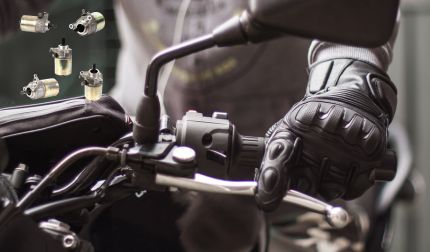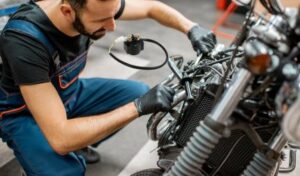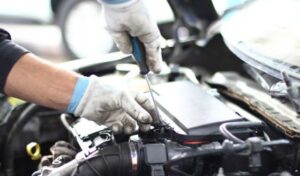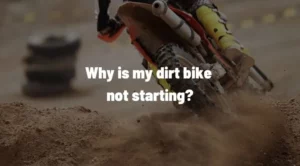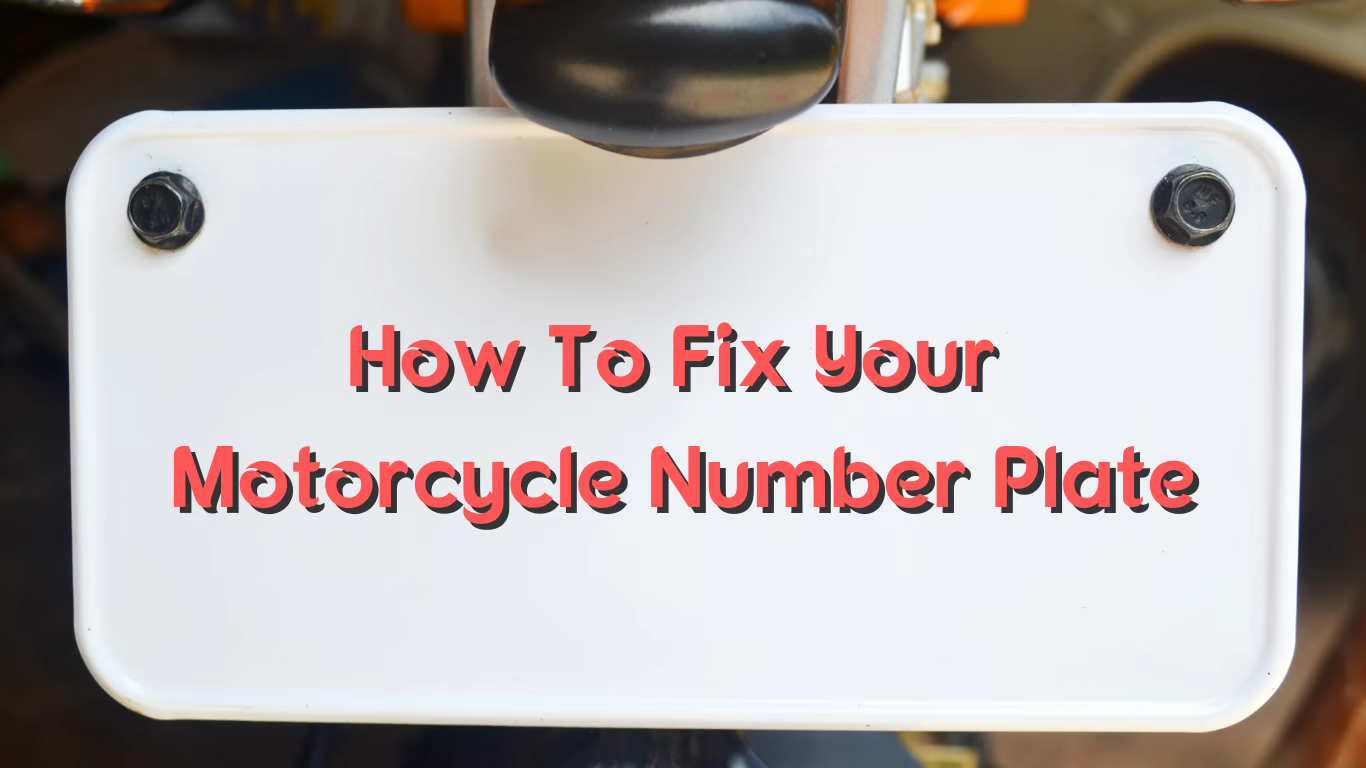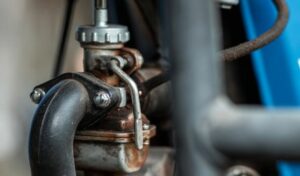Like any other mechanical equipment, a motorcycle is only as good as its component parts. The starting motor is one essential component that guarantees the bike runs smoothly. It is impossible to stress how crucial a motorbike starter motor is. It is the key component that ignites the process that causes your engine to scream to life and serves as the brain of the starting system. Without it, your motorbike is just a magnificent metal sculpture that cannot serve its intended function.
A motorbike starter system is made up of a number of linked parts. When you turn the key or press the start button, the ignition switch activates the starting relay, which starts the process. The starter motor is then given a strong current by the relay. The crankshaft is driven by the electric motor, which starts a series of events that end with the pistons firing and the engine starting.
Early detection of a defective starter is crucial for both the safety of the rider and the durability of the motorcycle. Not only is it frustrating when the starter motor breaks down, but it can also put you in danger. It might rapidly become a safety issue if you can’t start your motorbike in a busy place or in traffic. A bad starter can also increase wear on the motorcycle’s other parts, potentially necessitating expensive repairs if left unchecked.
You can take proactive measures to remedy difficulties before they worsen by being aware of the telltale indicators of a terrible start. The explanations provided in the sections that follow will help you stay informed and maintain the best possible running condition for your motorcycle.
What Are Motorcycle Starters?
Motorcycle starters vary in features and function. Motorcycles use kick-start and electric starting motors.
Types of Starter Systems in Motorcycles
- Electric Starter Motor: Modern motorbike starters are usually electric. The starting motor starts the motorcycle’s engine when you turn the ignition key or press the start button.
- Kick-start System: The kick-start method, seen in older motorcycles and some off-road bikes, starts the engine manually. The rider turns the engine by pushing a lever (the “kick starter”).
Working Principles of Motorcycle Starters
Here is the working principles of motorcycle starters:
Electric Starter Motor Operation:
Electromagnetism powers electric starter motors. The battery powers the starter solenoid when the ignition is on. The solenoid moves a starter motor gear to engage the engine flywheel. The flywheel spins the crankshaft, starting the engine’s cylinders’ intake, compression, combustion, and exhaust.
Kick-start System Mechanics:
Mechanical energy powers the kick-start. The gear shaft rotates when the cyclist kicks-starts. The clutch moves the crankshaft after this rotation. The crankshaft moves the pistons, which pull in the fuel-air combination, igniting the engine.
Diagnosing a defective starter requires understanding these systems’ mechanics. You’ll be able to spot possible issues and fix them before they get worse by understanding how each system operates.
5 Most Common Symptoms of a Bad Starter
Identifying a bad starter early on can save both time and money. Here are the common symptoms that could indicate a malfunctioning starter:
1. Slow or Hesitant Cranking:
Slow or hesitant cranking is a common symptom indicative of a faulty motorcycle starter. Under normal circumstances, when you engage the ignition switch, the motorcycle should respond immediately, with the engine quickly and smoothly roaring to life. This process is facilitated by the starter motor, which effectively converts electrical energy into mechanical energy to start the engine.
However, when the starter motor begins to deteriorate, it may struggle to generate sufficient force to initiate the engine’s operation. The manifestation of this is a slow or hesitant cranking of the engine when you attempt to start the motorcycle. Instead of the immediate response you would usually expect, the motorcycle might take longer to start or even require multiple attempts to get the engine running.
This delay can often be mistaken as a battery issue, as a weak or dead battery can also cause slow cranking. If the battery is healthy or the problem persists after replacing it, it’s likely a starter motor issue.
The slow cranking is often a result of worn-out components within the starter motor, such as the brushes or commutator, which affect the motor’s ability to create a magnetic field and generate torque. Additionally, a faulty starter solenoid could be at fault, failing to engage the starter motor properly.
Ignoring this symptom can lead to further deterioration of the starter motor and potentially strand you in a situation where the motorcycle refuses to start. If you notice your motorcycle cranking slower than usual, it is advisable to have it inspected by a professional to diagnose and rectify the problem promptly.
2. Grinding Noise During Startup:
A grinding noise during the startup of your motorcycle is a symptom that should never be ignored. This unsettling sound is typically associated with a failing starter motor and is often an indication that the gears within the starter system are not engaging correctly or are excessively worn.
The grinding noise is produced when the pinion gear of the starter motor is either not engaging properly with the flywheel, or is unable to disengage after the engine starts. In a healthy starter system, the pinion gear meshes seamlessly with the flywheel to crank the engine. Once the engine starts and runs independently, the gear should retract, disengaging from the flywheel. However, if the gear is worn or the solenoid is faulty, this disengagement may not happen smoothly, leading to the grinding noise as the gear and flywheel collide at high speed.
This grinding noise is disturbing and can damage the motorcycle’s engine. Continual grinding can wear down the teeth on the flywheel, leading to costly and labor-intensive repairs as replacing a flywheel is no small task.
This grinding noise is disturbing and can damage the motorcycle’s engine. This will help prevent further damage and ensure the longevity and reliability of your motorcycle.
3. Clicking Sound Without Engine Starting:
A clicking sound when you try to start your motorcycle, with the engine failing to ignite, is a common symptom of a bad starter. A failure in the starter system’s electrical circuit causes this clicking noise, which may be produced by the beginning motor or other components.
The clicking sound typically indicates that the starter solenoid, a switch-like device that controls the flow of high current to the starter motor, is receiving power from the battery. This power should be enough to pull in a contact, often referred to as a plunger, which completes the high current circuit to the starter motor, leading to the engine cranking.
However, if you only hear a clicking sound and the engine does not start, it’s likely that the high current needed for the starter motor to crank the engine is not being delivered. The cause of this could be a weak or discharged battery, poor electrical connections, particularly corroded or loose battery cables, or an issue within the starter motor itself.
If the battery and the connections are in good condition, the issue might be a faulty starter solenoid, which is not able to complete the electrical circuit. Another potential problem could be a fault within the starter motor, such as a bad commutator or worn brushes, which prevents the motor from producing the required torque to start the engine.
In any case, a clicking sound without the engine starting is a clear indication that your motorcycle needs attention. It’s crucial to diagnose the problem correctly, which might require the expertise of a professional mechanic, to ensure the correct issue is addressed and resolved.
4. Frequent Starter Motor Failures:
Frequent starter motor failures is a red flag that signifies a problem not just with the starter motor, but potentially with other aspects of the starting system or the motorcycle as a whole. A well-maintained and properly functioning starter motor should last for the majority of the motorcycle’s lifespan. If you find yourself regularly dealing with a failing starter motor, it’s a symptom indicative of a larger underlying issue.
The cause of frequent starter motor failures could be electrical, mechanical, or even due to irregular maintenance practices. Electrically, it could be due to a malfunctioning starter relay, poor wiring, or an overcharging alternator, all of which can stress and potentially damage the starter motor.
Mechanically, the issue could lie with the starter drive gear or the flywheel. If these parts are worn or not properly aligned, they could cause the starter motor to work harder than necessary, leading to premature failure.
Maintenance practices also play a significant role in the health of the starter motor. For instance, allowing the motorcycle to idle for prolonged periods or consistently starting the engine in low temperatures can lead to starter motor strain.
Additionally, improper installation of the starter motor or the use of subpar replacement parts could lead to recurring failures.
If your starter motor fails frequently, it’s important to seek the expertise of a professional mechanic. A thorough inspection of your motorcycle can help identify the root cause of these frequent failures and prevent future issues. Remember, treating the symptom without addressing the cause is only a temporary fix and could lead to more complex and costly repairs down the line.
5. Overheating Issues During Startup:
Overheating during startup is another symptom that may suggest a problem with your motorcycle’s starter motor. The starter motor is meant to crank the engine quickly but not for long-term use. If the starter motor is hot or overheating, especially during startup, it could indicate a problem in the starting system.
The overheating issue might arise when the starter motor runs for too long, often due to a malfunctioning ignition switch. The ignition switch should deactivate the starter motor after the engine starts.. If it fails to do so, the motor can continue to run, causing it to overheat.
Overheating can also be due to internal issues with the starter motor. Worn-out components, such as bearings or brushes, can increase resistance and friction, causing the motor to work harder and generate more heat.
Additionally, electrical issues can also lead to overheating. A short circuit within the motor, a faulty solenoid, or even poor wiring can result in excessive current flow, leading to increased heat production.
An overheating starter motor is not just a failure symptom, but also a cause for concern. Continued overheating can lead to severe damage, not only to the starter motor itself but also potentially to nearby components due to the excessive heat. If you notice an overheating issue during startup, it’s advisable to consult a professional mechanic for a thorough inspection and diagnosis to prevent further damage and ensure the safety of your ride.
Subtle Signs of a Faulty Starter
Some signs of a bad starter are obvious, but others may only appear occasionally or under specific conditions. These symptoms could indicate a starter motor problem that worsens over time. Here are some subtle warning signs:
Intermittent Starting Problems:
If your motorcycle occasionally fails to start, only to start perfectly a short while later, it could be a sign of a failing starter motor. This intermittent problem can occur due to various reasons such as a weak solenoid, worn-out internal components in the starter motor, or loose electrical connections.
Frequent Battery Drain:
Starter motor problems may cause your motorcycle’s battery to drain or need frequent charging. A failing starter motor may draw too much power, depleting the battery.
Dashboard Warning Lights or Error Codes:
While not every motorcycle has a dedicated warning light for the starter system, some modern models may indicate a starter motor issue through warning lights or error codes. Make sure to refer to your motorcycle’s manual to understand what each warning light or code signifies.
Starter Engagement Issues:
If the starter motor remains engaged even after the engine has started, it could indicate a problem with the starter drive mechanism or the ignition switch. A high-pitched whining sound might be heard once the engine starts running.
Smell of Burning or Electrical Odor:
A failing starter motor can often emit a burning smell or a distinctive electrical odor, especially if it’s overheating or if there’s an electrical short. This symptom could cause a fire and should be addressed quickly.
These subtle signs are just as important as the more obvious ones, but they require a keen eye and nose. If any of these signs appear, have a motorcycle mechanic inspect it. Preventing motorbike damage is best.
Troubleshooting a Bad Starter
When your motorcycle exhibits symptoms of a bad starter, some basic troubleshooting can help identify the problem before seeking professional help. A defective starter can be fixed step-by-step:
Precautions Before Diagnosing the Starter:
Safety should always be your priority. Before starting the diagnosis, ensure the motorcycle is on a flat surface and in a secure position. Disconnect the battery before inspecting electrical components to avoid any accidental electrical shocks or short circuits. Wear protective gear, including gloves and eye protection.
Testing the Battery and Connections:
First, check the battery’s health. A weak or dead battery may cause symptoms similar to a bad starter. Check battery voltage with a multimeter (for a fully charged battery). Also, inspect the battery cables and terminals for any signs of corrosion, looseness, or damage. Poor connections can impede the flow of electricity, causing starting issues.
Inspecting the Starter Solenoid:
The solenoid controls the flow of electricity from the battery to the starter motor. Listen for a clicking sound when attempting to start the motorcycle. If you hear a click but the engine doesn’t crank, the solenoid might be receiving power but failing to transfer it to the starter motor. In some cases, lightly tapping the solenoid with a tool can free it up, but this is only a temporary solution. A faulty solenoid usually needs replacement.
Evaluating the Starter Motor Brushes:
Over time, the brushes inside the starter motor can wear out. Although inspecting them typically involves dismantling the motor, visible signs like excessive dust around the motor, sparks while attempting to start, or a burnt smell could suggest worn brushes. Keep in mind that dismantling the starter motor should be left to a professional, as improper assembly can lead to further issues.
Analyzing the Starter Gear or Bendix:
The starter gear, also known as a bendix, is the component that engages with the flywheel to crank the engine. Over time, this gear can wear out or fail to engage properly. Signs of a bad bendix might include a grinding noise during startup or the starter motor spinning without cranking the engine. Inspecting the bendix usually involves removing the starter motor, a task best left to professionals.
While these steps can help identify potential issues, diagnosing and repairing a motorcycle starter system often involves dealing with high currents and complex mechanical components. If you’re unsure, ask a skilled mechanic to ensure safe and successful repairs.
Preventive Maintenance for Starters
A sound preventive maintenance program can help extend the life of your motorcycle’s starter and prevent most starter-related issues. Here are some key strategies to consider:
- Regularly inspect your battery for any signs of wear, corrosion, or damage. Check the voltage periodically with a multimeter to ensure it is maintaining a charge around 12.6 volts for a fully charged battery. Remember, a failing battery can put undue stress on the starter system.
- Cleaning and Lubricating the Starter System: Regular cleaning and lubrication can prevent starter system issues. Remove any dust, dirt, or grime that could inhibit the starter motor’s performance. Regularly lubricate the starter motor and other components, such as the bendix, to minimize friction and ensure smooth operation.
- Inspection and Replacement of Starter Components: Regularly inspect the starter motor, solenoid, and other starter system components for any signs of wear or damage. Replace worn-out parts promptly to prevent more serious issues down the line. While some parts, like brushes, can often be replaced, severe internal damage may necessitate a full starter motor replacement.
- Maintaining Proper Wiring Connections: Check the wiring connections within the starter system regularly. Look for any signs of damage, corrosion, or loose connections that could inhibit the flow of electricity. Remember, poor electrical connections can mimic the symptoms of a bad starter.
- Avoiding Excessive Cranking Attempts: If your motorcycle fails to start, avoid excessive attempts to crank the engine. Too many attempts can overheat the starter motor and potentially damage other components. Diagnosis is needed if your motorbike won’t start after several attempts.
Adopting these preventive maintenance practices can help ensure the longevity and reliability of your motorcycle’s starter system. Regular maintenance prevents unexpected problems and saves time, money, and stress.
Professional Help and Expert Advice
Despite your best preventive maintenance efforts and troubleshooting abilities, there may be times when professional help is necessary to diagnose and repair a bad starter. Here are some guidelines to consider:
When to Seek Professional Assistance:
If you’ve checked the basic components like the battery and wiring connections and are still having issues, it may be time to consult a professional. Also, if you’re not comfortable or experienced in working with electrical systems or mechanical components like the starter motor, it’s best to seek professional help to avoid causing further damage or potential safety risks.
Tips for Choosing a Reliable Motorcycle Mechanic:
Look for a motorcycle mechanic who specialises in your model. Check online reviews and ask for recommendations from fellow riders. Verify their qualifications and certifications. Don’t hesitate to ask about their experience and the repair process. Remember, a good mechanic will take the time to explain the issue and the necessary repairs to you.
Consulting Online Forums and Communities:
Online motorcycle communities can be a wealth of knowledge. If you’re experiencing an issue with your starter, someone else likely has too. Forums can provide real-world advice, troubleshooting tips, and recommendations for professional mechanics. Be careful and verify the advice, as it may not apply to your situation.
The Importance of Motorcycle Service Manuals:
Service manuals provide detailed information about your motorcycle, including the starter system. They can teach you how your motorbike works, troubleshoot, and maintain it. You can usually find a service manual for your specific model from the manufacturer or online.
Exploring Manufacturer Warranty and Support Options:
If your motorcycle is relatively new or under warranty, check with your manufacturer for repair options. Some issues with the starter might be covered under the warranty. Even if your motorcycle is no longer under warranty, the manufacturer can often provide support or recommend trusted repair shops.
When necessary, get professional help maintaining and troubleshooting your motorcycle’s starter. An expert can provide the most reliable advice and perform the necessary repairs to get your motorcycle back on the road.
Frequently Asked Questions (FAQs):
The motorcycle’s make, model, riding conditions, and maintenance affect the starter’s lifespan. A well-maintained starter motor in a motorcycle ridden regularly under normal conditions should last several years, often for most of its lifespan. Short trips, idling, and harsh riding conditions can shorten this lifespan.
Bad starters can drain batteries. An internal short in the starter motor can drain the battery quickly. If the starter solenoid fails, the starter motor will stay engaged longer, draining the battery.
Starter motor failure has many causes. Faulty solenoids, wiring, and alternators can cause failure. A worn starter drive gear or flywheel can also cause problems. Allowing the motorcycle to idle or starting the engine in low temperatures can cause premature starter motor failure. Substandard parts or improper installation can also cause frequent failures.
Jump-starting a motorcycle with a bad starter is possible. However, this would only work if the starter’s problem is power, such as a weak battery or poor connections. Jump-starting the motorcycle won’t work if the starter motor is mechanically or electrically defective.
The fault determines whether a starter can be repaired or replaced. Repairs can fix worn brushes and faulty solenoids. In cases of extensive internal damage or overheated starter motors, replacement may be the only option. For advice, consult a mechanic.
